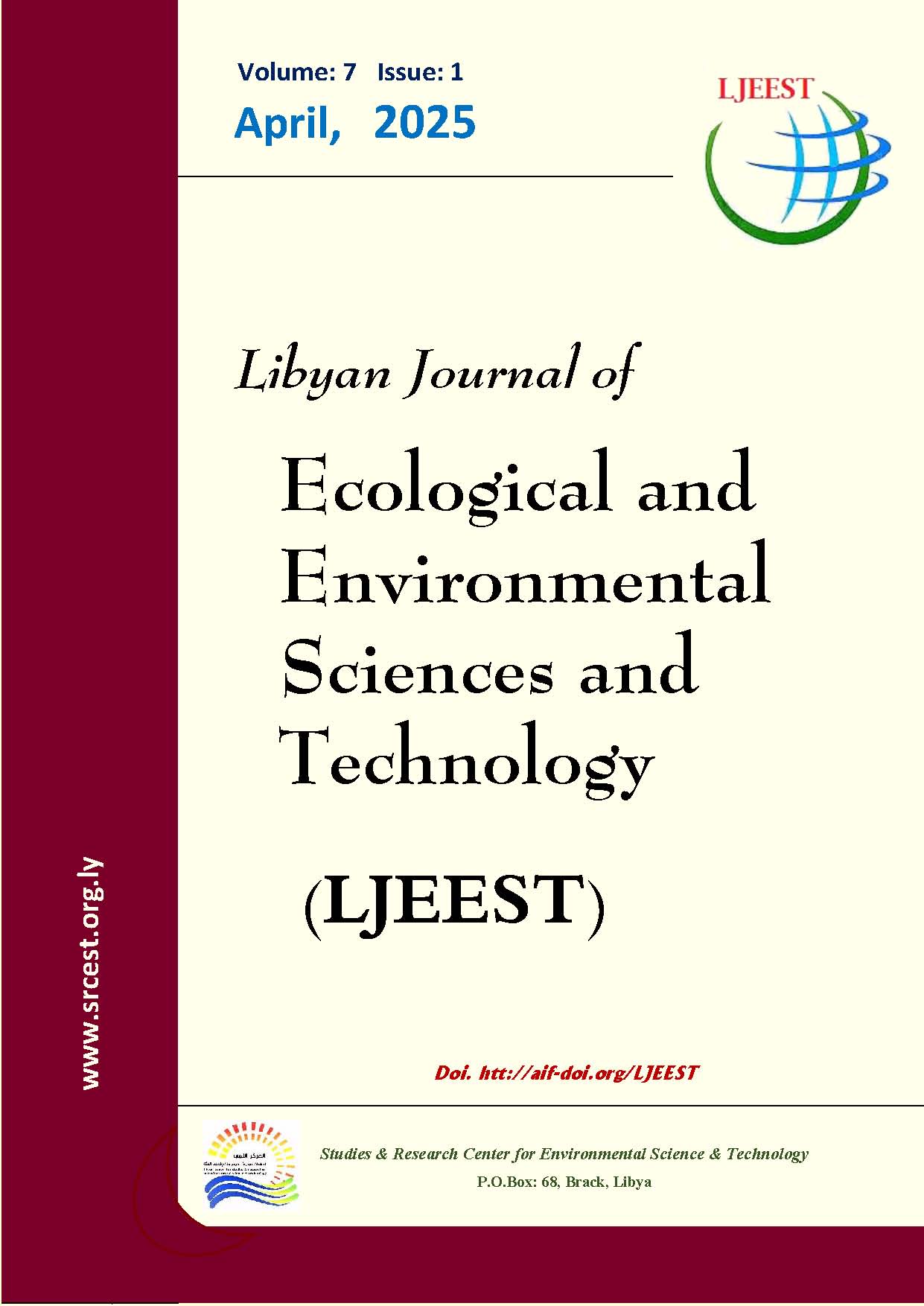Physical Effect Characteristics on Spread and Abundance of Arbutus pavarii Pamp Plant in Green Mountain Region, Libya
DOI:
https://doi.org/10.63359/9458bv51Keywords:
Arbutus pavarii, Soil factor, Green Mountain, LibyaAbstract
Arbutus pavarii Pamp is one of the most important endemic species in the Green Mountain region and is one of Libya's national natural resources. Naturally, the sustainable management and conservation of endemic and rare plants is essential to preserve global biodiversity, as the importance of these species and knowledge of their distribution and environmental characteristics to manage them in a sustainable manner and develop effective strategies for their conservation are not limited to the local level only. In this study, the effect of one of the environmental factors affecting the spread and abundance of the Shammari plant in the Green Mountain region was addressed, as it is a national natural resource that should be preserved, namely:
• The soil factor represented by:
A- Physical characteristics: In terms of soil texture, the highest presence of the Shammari plant is on calcareous soils, shallow and rocky soils, which are heavy red clay soils (Terra rossa), where the components of the soil sections of the third terrace were the highest abundance of the Shammari plant (clay (24.5%), clayey silt (10.2%), and silt (2.00%(
References
أبو سمور، حسن يوسف. (2013). الجغرافيا الحيوية والتربة . الطبعة الثالثة. دار المسيرة للنشر والتوزيع ، عمّان.
الأندلسي، عبدالحي بن عطيه. (1986). دليل المراعي في المناطق القاحلة. إصدار المنظمة العربية للتربية والثقافة والعلوم، مشروع الحزام الأخضر لدول شمال أفريقيا، اهداء ديوان تربية الماشية وتوفير المرعى- وزارة الفلاحة، الجمهورية التونسية.
بن محمود، خالد رمضان. (1995). الترب الليبية تركيبها – تصنيفها – خواصها- إمكانياتها الزراعية . الهيئة القومية للبحث العلمي، طرابلس، ليبيا.
بن محمود، خالد رمضان؛ والجنديل، عدنان رشيد. (1984). دراسة الترب في الحقل. منشورات جامعة الفاتح.
. جامعـة عمر المختار ومشروع جنوب الجبل . (2005). دراسة وتقييم الغطاء النباتي الطبيعي بمنطقة الجبل الأخضر، التقرير النهائي . ليبيا، البيضاء.
جويفــل، إسماعيل.؛ إسماعيل، حسن.؛ دياب، جمال؛ الشيمي، حسن.؛ عمارة، مصطفى. والحارس، ممدوح. (2000). أساسيات علم الأراضي، دار الفكر العربي للطباعة والنشر، القاهرة.
حافــظ، محمد السيد. (2007). ندوة حول حماية التربة في المناطق الجافة وشبه الجافة. مجلة كلية الآداب، جامعة الأسكندرية ، فرع دمنهور.
حســـن، محمد. (1999). أنماط التربة ومصادر المياه والتلوث البيئي في الفكر الجغرافي الحديث. مكتبة جامعة الإسكندرية للطباعة والنشر، مصر.
شلتــوت، كمال حسين. (1997). علم البيئة النباتية. منشورات المكتبة الأكاديمية، الدقي ، القاهرة، مصر.
عبدالخالـق، يونس محمود. (2007). دراسة الغطاء النباتي لمرتفعات الباكور بالجبل الأخضر. رسالة ماجستير، قسم علم النبات، كلية العلوم، جامعة قاريونس، نغازي
Abagandura, G.O.; Park, D.M. (2016). Libyan Agriculture: A Review of Past Efforts, Current Challenges and Future Prospects . Journal of Natural Sciences Research, ISSN 2224-3186, Vol.6, No.18 ,57-67.
Abagandura, G.O.; Park, D.M. David, W. & Bridges, W. (201X), “An Assessment of Soil Resources and Soil Degradation in Libya”, AMBIO. In review.
Abdelwahed, A. A. ; Mahdi, A. Zikri, B.S. (1978). Soil of the Eastern Region of Libya, Middle East Research Center, Ain Shams University press, Cairo.
Aburas, M. (2009). Assessment of Soil Erodibility in Relation to Soil Degradation and Land Use in Mediterranean Libya. PhD thesis. University of Newcastle upon Tyne. UK.
Aburas, M. M., E. E. Yousif and M. E. Fawzi. (2001). Effects of land use on soil erosion by rain and on the loss of some soil constituents in Al-Jabal Alkhdar, Libya. University of Khartoum Journal Agriculture Sciences, 9: 201-217. 2001.
Bittelli, M.; F. Salvatorelli, and P. Rossi Pisa. (2008). Correction of TDR-based soil water content measurements in conductive soils. Geoderma 143:133–142.
Bittelli, Marco. (2011). Measuring Soil Water Content. 21(3):2933–300. E-mail: marco.bittelli@unibo.it.
Bosch, D. D. and K. W. King. (2001). Preferential flow, water movement
Cohen, S.S.; J. Gale, A.; Shmida, A.;Poljakoff-Mayber. and Suraqui, S. (1981). Xeromorphism and potential rate of transpiration on Mount Hermoun an EastMediterranean mountain. Journal of Ecology 69, pp 391-403.
El shatshat, S.(2009). Biological conservation of the endemic Arbutus pavarii Pamp.: Seed germination as attempt. International Journal of Human Geography And Environmental Studies. 11: 333–335
El shatshat, Salem. and Elshibani, Fatma. (2020). Characteristics, Nutritive Value and Antioxidant Content of the Libyan Endemic (Arbutus pavari Pamp.) Strawberry tree Fruits .EPRA 5 (9):255-260.
Evans, R.; Cassel, D.K. and Sneed, R.E. (1996). Measuring Soil Water for Irrigation Scheduling: Monitoring Methods and Devices. NCCES.
Fankem, H. ; D. Nwaga ; A. Deubel ; L. Dieng ; W. Merbach and F. X. Etoa. (2006). Occurrence and functioning of phosphate solubilizing microorganisms from oil palm tree (Elaeis guineensis) rhizosphere in Cameroon. African J. Biotech. 5 : 2450-2460.
Farrington, P. and Campbell, N.A. (1970). Properties of deep sandy soils and the growth of Lovegrass, Eragrostis curvulo (schrad.) Nees. Australian Journal of Soil Research 8: 123-I32.
Gardner, R.C. (2003). Genes for magnesium transport. Curr Opin Plant Biol 6:263–267.
Garg, B.K., Garg, O.P.: Influence of sodium bicarbonate on growth, nutrient uptake and metabolism of Pea. – Ann. Arid Zone 25: 69-72, 1986.
Hayes, M. HB. And Clapp, C.e. (2001).Humic substance considerations of compositions aspects of structure and environment influences.J. Soil Sci.,166 (11): 732.737.
Hazleton, Pam and Murphy, Brian. (2007). Interpreting Soil Test Results: What do all the numbers mean? , Published by CSIRO, Australia, www.publish.csiro.au.
Hoyle, F.. (2013). Managing Soil Organic Matter: Apractical Guide. Australia
Huber,D.M. and Jones, J.B. (2013). The role of magnesium in plant disease. Plant and Soil 368, 73–85. doi:10.1007/s11104-012-1476-0
Huisman, J.A.; Hubbard, S.S.; Redman, J.D. and Annan, A.P. (2003). Measuring soil water content with ground penetrating radar: a review. Vadose Zone J. 2, 476–491.
IPI (International Potash Institute). (2001). Potassium in plant production. Basel/Switzerland. 1-44.
IPNI (International Plant Nutrition Institute). (2021). www.PINI.NET.
IUCN. (2013).IUCN Red List of Threatened Species. Version(2), www.iucnredlist.org.Accessed on May (2014).
Jabeen, T. and Ahmed, S.S. (2009). Multivariate analysis of environmental and vegetation data of Ayub National Park Rawalpindi. Soil and Science Society of Pakistan (Soil& Environ), 28(2): 106-112, ISSNP 2074-9546(P).
Jahnen-Dechent, Wilhelm. and Ketteler, Markus. (2012). Magnesium basics. Clin Kidney J (2012) 5[Suppl 1]: i3–i14
Jennings, S.; Brown, N. and Sheil, D. (1999). Assessing forest canopies and understorey illumination: Canopy closure, canopy cover and other measures. Forestry, vol. 72, pp. 59–74.
Keith, H.G. (1965). A preliminary check list of Libyan flora. Libya Ministry of Agriculture, Tripoli.
Khresat, S.A. ( 2001). Calcic horizon distribution and soil classification in selected soils of north-western Jordan. J Arid Environ. 47:145-52. doi:10.1006/jare. 2000.0712
Kidd, P.S. and J. Proctor. (2001). Why plants grow poorly on very acidic soils: are ecologists missing the obvious? Journal of Experimental Botany. 52:791-799. doi:10.1093/ jexbot/52.357.
Kimeu, John Mbaluka. (2015). Ecological Factors Influencing Distribution Patterns of Three Aristida Species and Their Associated Species in Kifuko Ranch, Laikipia County, Kenya, Faculty of Science – Plant Ecology, Kenyatta University.
King, D. A. (1991). The adaptive significance of tree height. Am. Nat. 135, 809–828.
King, D.A. & Clark, D.A. (2011) Allometry of emergent tree species from saplings to above-canopy adults in a Costa Rican rain forest. Journal of Tropical Ecology, 27, 573–579.
Koch, George. W. ; Siiiett, C. Stephen.; Jennings, Gregory. M. and Davis,Stephen. D. (2004). The Limits to Tree Height. Nature, 428, 851-854.
Kosmas, C.; Danalatos, N. G. and Gerontidis, S. (2000). The effect of land parameters on vegetation performance and degree of erosion under Mediterranean conditions. CATENA., 40: 3-17.
Kron, K.A., Stevens, P.F., Crayn, D.M., Anderberg, A.A., Gadek, P.A., C.J., Q., Luteyn, J.L., 2002. Phylogenetic classification of Ericaceae: molecular and morphological evidence. The Botanical Review 68, 335-423.
Kuprevicius, A.; Auty, D.; Achim, A. and Caspersen J.P. (2014). Quantifying the influence of live crown ratio on the mechanical properties of clear wood. Forestry 86(3): 449–458. https://doi. org/10.1093/forestry/cpt006.
Mathilde, S. and Alexandra, B. (2002). Proposed indicators for land degradation assessment of drylands. LADA e-mail Conference of Properties and Management of Drylands. 9th of October to 4th of November. Proposed indicators for land degradation assessment of drylands: Land and water Development Division, FAO, Italy.
Oades, J.M. (1993). The role of biology in the formation, stabilization and degradation of soiI structure. Geoderma 56: 377-400.
Siddiqi, M.A. (1978). Flora of Libya. Vol. 54 (Ericaceae), Al Faateh University, Faculty of Science Department of Botany, Tripoli – Libya.
Tenuta, M.C.; Tundis, R.; Xiao, J.; Loizzo, M.R.; Dugay, A.; Deguin, B. Arbutus species (Ericaceae) as source of valuable bioactive products. Crit. Rev. Food Sci. 2019, 59, 864–881. [CrossRef]
Thirumalini, S. and Kurian, J. (2009). Correlation between Electrical conductivity and total dissolved solid in Natural waters. Malaysian Journal of Science, Vol.28 , No 1, pp. 55—61.
Tomasic,Marija. ; Zgorelec, Ţeljka.; Jurisic, Aleksandra. and Kisic,.Ivica, (2013). Cation Exchange Capacity of Dominant Soil Types in the Republic of Croatia. Journal of Central European Agriculture, 14(3), 937-951.
Tonggui, W.U.; Ming, W.U.; Mukui, Y.U. and Jianghua, Xiao. (2011). Plant Distribution in Relation to Soil Conditions in Hangzhou Bay Coastal Wetlands, China. Pak. J. Bot, 43(5): 2331-2335.
Torres, J.A.; Valle, F.; Pinto, C.; Garcia-Fuentes, A.; Salazar, C.; Cano, E. (2002). Arbutus unedo communities in southern Iberian Peninsula mountains. Plant Ecol. 160, 207-223.
Tutin, T.G., Heywood, V.H., Burges, N.A., Valentine, D.H., Walters, S.M., Webb, D.A. (1972). Flora europea. Vol. 3. Cambrige Univ. Press, Cambrige.
USDA. (1987). Soil Mechanics level 2 Module 3 USDA Textural Classification Study Guide, USDA, Retrieved.
Yin, Z.; Lei, T.; Yan, Q.; Chen, Z. and Dong, Y. (2013). A near-infrared reflectance sensor for soil surface moisture measurement. Comput. Electron. Agric. 99, 101–107
Downloads
Published
Issue
Section
License
Copyright (c) 2025 Libyan Journal of Ecological & Environmental Sciences and Technology

This work is licensed under a Creative Commons Attribution-NonCommercial 4.0 International License.














